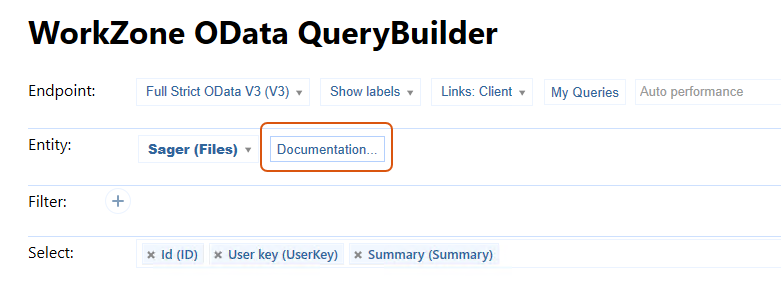Updated: 12/03/2025
FAQs
This section contains a list of frequently asked questions on WorkZone functionality. Click any question below to see the answer.
General Oracle questions
Schema objects can be rendered invalid after a database conversion, upgrade or patch installation or Data Definition Language (DDL) changes. You can recompile invalid schema objects, either manually, using a custom script or using one of Oracle packages. If the objects are still invalid after this, you can either ignore or delete them.
For more information regarding invalid schema objects, see Recompiling Invalid Schema Objects (external link to Oracle online documentation.
That depends. By default, WorkZone does not utilize database links when initially installed but the links can be added later and might be used by other customizations or user-defined integrations into WorkZone. If you want to change the characteristics of the database links, you should investigate who/what uses the database links before changing or removing them.
You certainly can remove these rights, but be aware of the following:
- The SJSYSADM user is usually only used when installing and/or upgrading the database and is inactive (from the WorkZone perspective) otherwise however, some Oracle jobs may run with the SJSYSADM as owner and some customizations may have been implemented to use the SJSYSADM user for batch job execution.
- The SCANSQL tool must be run as the SJSYSADM user.
If you remove log-in rights for the SJSYSADM user, you should also note the following:
- The SYSYSADM user must be re-instated when upgrading or patching the database or whenever KMD-based technicians are to access the system to troubleshoot issues, implement customizations or provide support and assistance during normal or interrupted operations.
As an alternative to completely restricting log-in using the SJSYSADM user account, some organizations issue temporary passwords to the SJSYSADM and change the password after all work is complete. Other organizations increase system auditing of the account, tracking all transactions and actions performed by the account for improved transparency and traceability.
There are two ways of generating a description of the WorkZone data model depending on whether you need a description of the entire model in a document, or you want to look up descriptions of specific entities online.
Generate a data model document
Some organizations have a need for a document that describes the tables and fields of the WorkZone data model, for example to comply with rules and regulations in connection with delivery of archived documents to a central archive.
-
On the web server, go to:
C:\ProgramData\ScanJour\DataDict\<database>
-
Double-click the
Configuration-da-DK.xmlfile to generate a document that describes the tables and fields of a specific WorkZone installation.
Export a list of all tables including number of rows per table
Central archives may also require information about all tables and the number of records in each table. To extract this information, the SJSYSADM user can execute a script in SQL Plus that creates a CSV file with ";" as the separator. The CSV file can then be imported in to Microsoft Excel.
set term off
set long 2000
set arraysize 1
set pagesize 0
set echo off
set trimspool on
set feedback off
set recsep off
set line 400
set verify off
set serveroutput on
spool table_count.csv
declare
type t_tables is table of user_tables.table_name%TYPE
index by pls_integer;
wz_user_tables t_tables;
i number;
cnt number;
begin
dbms_output.put_line('"Table name";"Number of rows in the table"');
select table_name bulk collect into wz_user_tables from user_tables
where table_name not like 'DR$%'
and nvl(IOT_TYPE,'#') <> 'IOT_OVERFLOW'
order by table_name;
for i in wz_user_tables.first .. wz_user_tables.last loop
EXECUTE IMMEDIATE 'select count(*) from "' || wz_user_tables(i) || '"' into cnt;
dbms_output.put_line('"' || wz_user_tables(i) || '";"' || to_char(cnt) || '"');
end loop;
end;
/
spool off
set feedback on
set recsep wr If there are tables that you do not want to extract, you can edit the script.
Tables that start with DR$ in the table name are not extracted because they are the tables that Oracle generates when the WorkZone free text index is created.
Look up documentation in WorkZone QueryBuilder
If you need to know about properties of specific entities in the WorkZone data model, for example, if your organization develops integrations to WorkZone, you can click the Documentation button in WorkZone QueryBuilder to view the documentation for all entities or for a selected entity.

Log tablespace
The SJ_LOG tablespace contains the use log, which logs all user transactions, for example when users search, create, update, edit, and delete cases and documents.
For more information about the Use log and how to use it, see Use logs and deletion logs
The use log is saved in a table corresponding to each month. When a table becomes too old, it is renamed to TO_BE_DROPPED_USE_LOG_<YYYYMM>. You can choose to export these tables and then drop them or simply drop them.
See Set up the use log.
Yes, you can rotate data. In a standard configuration, the default rotation is set to 6 months but you can change the default using ScanSQL. See Set up and maintain use logs.
Capacity management
Tablespaces should always be monitored to make sure that they are not running full. The WorkZone tablespaces that grow the most are:
- SJ_ARKIV_CAPTIA
- SJ_DATA_IMT
- SJ_DATA
- SJ_LOG
See DBA operations.
There is no such queue. However, be aware that WorkZone PDF Crawler takes documents based on the LIFO principle (last in, first out): the polices select the documents which are newly added and start conversion with them.
However, it is possible to view the documents that are converting at the current time. To do this, access the DVS_RENDER_INFO table and view documents with state PENDING.

